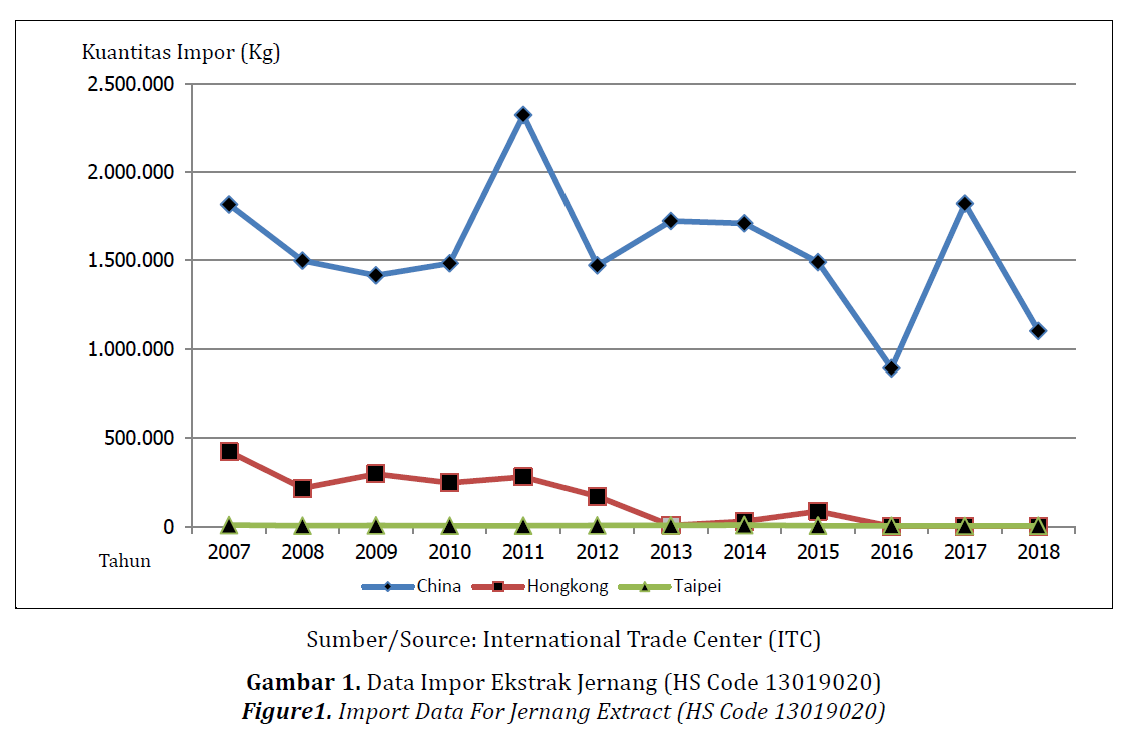Forecasting The Demand of Jernang Extract (Daemonorops spp) in The Export Market

Downloads
One indicator of a country’s progress is economic growth. In an economic growth, export is an important component in contributing to a positive trade and balance. Indonesia as one of the developing countries always looking for a various way to increase the number of export value. To achieve thesegoals, Indonesia started the exploitation of its forest to obtain more valuable commodities that are in demands by the global markets.One of the high-value forest plants that have the zero potential to the environment damage is the Jernang extract (Daemonorops sp)that has been used as a raw material in the manufacture of the traditional medicine in several countries, e.g. China, Taiwan, and Hong Kong. The opportunity to make Jernang extract as one of the major foreign commodities for the country’s development is relatively open. But in the current situation, the utilization of Jernang extract has not been fully used and the matter of fact that there is limited information about the world’s demand for the Jernang extract. The aim of this study isto find out the possibility of the needs of Jernang extract in the future. All the data regarding the Jernang extract will be processed using the methodology of Single Exponential Smoothing Techniques. The result of this studyshows that the demand of jernang was fluctuated but still in the trend of large demand. This study recommends that the government need toencourage people to develop Jernang plantation.
Arsyad, L. (1994)). Peramalan Bisnis. Yogyakarta: BPFE Yogyakarta
Cunningham, A. B., Brinckmann, J.A., Yang, X., He, X. J. (2019). Introduction to the special issue: Saving plants, saving lives: trade, sustainable harvest and conservation of traditional medicinals in Asia. Journalof Ethnopharmacology 229:288-292.
Fandeli, C. (2012). Bisnis Konservasi, Pendekatan Baru Dalam Pengelolan Sumberdaya Alam & LingkunganHidup. Yogyakarta: Gadjah Mada University Press.
Fitriandi, D. (2019). Manfaat Penggunaan Internet Sebagai Tool Bisnis Pada Usaha Ekstrak Jernang (Daemonorops Spp) Dengan Pendekatan Kanvas Model Bisnis Tesis. Tidak Diterbitkan. Yogyakarta: Fakultas Pertanian. Universitas GadjahMada.
Gupta, D., Bleakley, B. & Gupta, R. K. (2008). Dragon's blood: Botany, chemestry and therapeuticuses. Journal of Ethnopharmacology, 115(3), 361-380. DOI: 10.1016/j.jep.2007.10.018
Harnov., Amzu, E., Soekmadi, R. (2016). Konservasi Hutan Belajar Dari Nilai-Nilai Etik & Tradisi Berjernang Suku Anak Dalam di Taman Nasional Bukit Dua Belas, Provinsi Jambi. Risalah Kebijakan Pertanian & Lingkungan, 3(1), 24 -38. DOI: http://dx.doi.org/10.20957/jkebijakan.v3i1.15233
Hilmato, R. (2010). Transformasi Budaya Agrofrestri Lokal dalam Menghadapi Kesepakatan Perdagangan Bebas. Jurnal Penelitian Politik, 7(2), 77 - 87.
ITC. (2018). International Trade Centre. www.intracen.org. Diakses online dari http://www.intracen.org/itc/about/ pada tanggal 30 Desember 2018
IUCN. (2019). IUCN Red List of Threatened Species. [diunduh pada tanggal 10 April 2019. Tersedia pada https://www.iucn.org-red-list-threatened-species-test-single-page
Lestari, S., Pramono, B. T. & Martin, E. (2017). Rotan Jernang Sebagai Penopang Kehidupan Masyarakat: Kasus Kabupaten Muara Enim, Sumatera Selatan. Jurnal Penelitian Sosial dan Ekonomi Kehutanan, 14(3), 191-203. doi: http://dx.doi.org/10.20886/jpsek.2017.14.3.191-203
Lubis, A. (2013) Competitiveness, Trade Performance, and LiberalizationImpact of Forestry Product. Buletin Ilmiah Litbang Perdagangan, 7(1), 37 - 54. DOI: https://doi.org/10.30908/bilp.v7i1.99
Makower, J. (2009). Strategies For The Green Economy : Opportunities & Challenges In The New World Of Business. New York. McGraw Hill
Matangaran, J., R. & Puspitasari, L. (2012). Potensi dan Pemanenan Buah Rotan Jernang. Jurnal Silvikultur Tropika, 3(1), 65-70.
Meadows, D., Meadows, D. & Rounders, J. (1992). Beyond The Limits. London. Earthscan Publications Ltd
Merdeka.com. (2005). China Butuh 400 Ton Jernang Rotan dari Indonesia. Diakses dari https://www.merdeka.com/uang/china-butuh-400-ton-jernang-rotan-dari-indonesia-bz6qu2l.html. Tanggal 5 Desember 2018
Nahin, Richard L., Barnes, Patricia M., Stussman, Barbara J., Bloom, Barbara. (2009). Costs of Complementary and Alternative Medicine (CAM) and Frequency of Visits to CAM Practitioners: United States, 2007. Amerika. National Health Statistics Reports.
Nazir, M. (1988). Metode Penelitian. Jakarta: Ghalia Indonesia.
NDRC. (2013). Analysis Of The Economic Status Of The Chinese Medical Industry In 2012. China. National Development and Reform Commission of China.
Purwanto, Y., R. Polosakan, S. Susiarti, & E.B. Walujo. (2005). Ekstraktivisme jernang (Daemonorops spp.) dan kemungkinan pengembangannya: studi kasus di Jambi Sumatra Indonesia. Laporan Teknik. Bidang Botani Pusat Penelitian Biologi-LIPI.
Salvatore, D. (2001). Managerial Economics Dalam Perekonomian Global, Edisi Ke 4, Jilid 1. Jakarta: Penerbit Erlangga.
Sahwalita. (2014). Budidaya Rotan Jernang. Palembang. Balai Penelitian Kehutanan, Kementerian Lingkungan Hidup & Kehutanan Republik Indonesia.
Sasono, B. (2013). Manajemen Ekspor & Perdagangan Internasional. Yogyakarta: Penerbit Andi.
Subagyo, P. (2002). Forecasting: Konsep & Aplikasi. Yogyakarta: BPFE Ekonomi UGM
Suryantoro, A. (2011). Dampak Liberalisasi Terhadap Perekonomian Indonesia. Jurnal Ilmu Ekonomi Pembangunan, 11(1), 36 – 65.
United Nations Environment Programme (UNEP). (2011). Towards a Green Economy: Pathways to Sustainable Development and Poverty Eradication - A Synthesis for Policy Makers. UNEP
Waluyo, T.K. (2008). Teknik Ekstraksi Tradisional & Analisis Sifat-Sifat Jernang Asal Jambi. Jurnal Penelitian Hasil Hutan, 26(1),30-40.
Waluyo, T.K., & Pasaribu, G. (2012). Aktivitas Antioksidan & Antikoagulasi Resin Jernang. Jurnal Penelitian Hasil Hutan, 31(4), 306-315.
WHO. (2014). WHO Traditional Medicine Strategy 2014 – 2023. Geneva, Switzerland. World Health Organization.
Whitney, F., L. (1950). The Elements of Research. New York. Prentice Hall
Wicaksono, B. (2014). Analisis Tataniaga Buah Jernang Rotan (Studi Kasus : Hutan Desa Lamban Sigatal, Kecamatan Pauh, Kabupaten Sorolangun, Provinsi Jambi). Departemen Agribisnis, Institut Pertanian Bogor.
Widianingsih, N. N., Schmidt, L. H., & Theilade, I. (2019). Jernang (Daemonorops spp.) Commercialization & Its Role For Rural Incomes & Llivelihoods In Southern Sumatra, Indonesia. Forests, Trees and Livelihoods. DOI 10.1080/14728028.2019.1600434
WPRO. (2012). The regional strategy for traditional medicine in the Western Pacific (2011–2020). Manila. WHO Regional Office for the Western Pacific.
Yetti., Hariyadi, B., Murni, P. (2013). Ethnobotany of Jernang (Daemonorops spp) In The Community of Lamban Sigatal & Sepintun, Pauh, Sariongun, Jambi. Jurnal Biospecies, 6(1), 38-44.




